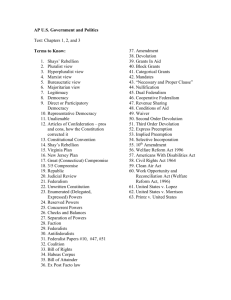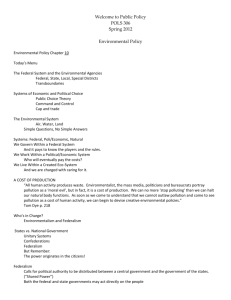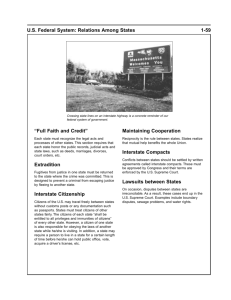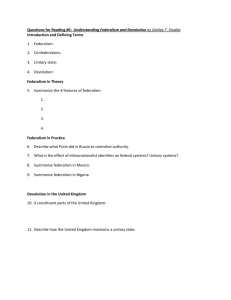Caldwell 1 Stephen Caldwell Professor Gormley PPOL
advertisement
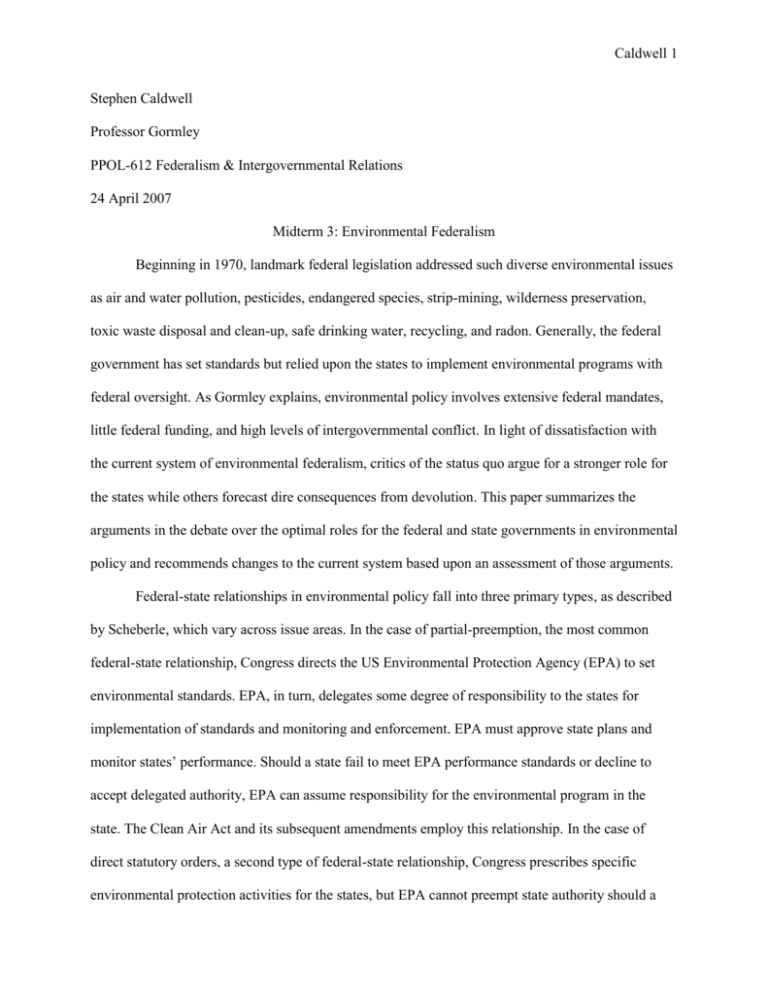
Caldwell 1 Stephen Caldwell Professor Gormley PPOL-612 Federalism & Intergovernmental Relations 24 April 2007 Midterm 3: Environmental Federalism Beginning in 1970, landmark federal legislation addressed such diverse environmental issues as air and water pollution, pesticides, endangered species, strip-mining, wilderness preservation, toxic waste disposal and clean-up, safe drinking water, recycling, and radon. Generally, the federal government has set standards but relied upon the states to implement environmental programs with federal oversight. As Gormley explains, environmental policy involves extensive federal mandates, little federal funding, and high levels of intergovernmental conflict. In light of dissatisfaction with the current system of environmental federalism, critics of the status quo argue for a stronger role for the states while others forecast dire consequences from devolution. This paper summarizes the arguments in the debate over the optimal roles for the federal and state governments in environmental policy and recommends changes to the current system based upon an assessment of those arguments. Federal-state relationships in environmental policy fall into three primary types, as described by Scheberle, which vary across issue areas. In the case of partial-preemption, the most common federal-state relationship, Congress directs the US Environmental Protection Agency (EPA) to set environmental standards. EPA, in turn, delegates some degree of responsibility to the states for implementation of standards and monitoring and enforcement. EPA must approve state plans and monitor states’ performance. Should a state fail to meet EPA performance standards or decline to accept delegated authority, EPA can assume responsibility for the environmental program in the state. The Clean Air Act and its subsequent amendments employ this relationship. In the case of direct statutory orders, a second type of federal-state relationship, Congress prescribes specific environmental protection activities for the states, but EPA cannot preempt state authority should a Caldwell 2 state fail to follow Congress’s mandate. Rather, Congress may withhold federal grant monies for other programs should states fail to follow direct statutory orders. For example, under the 1986 amendments to the Safe Drinking Water Act, Congress mandated specific wellhead protection programs for the states. Finally, in the case of voluntary relationships, Congress uses federal matching grants to induce states to engage in desired activities. With the Indoor Radon Abatement Act, Congress followed the voluntary model. Whereas the deluge of federal environmental regulation in the 1970s placed great burdens on states, the 1980s and 1990s saw a trend toward devolution. President Reagan attempted to delegate more responsibility to states in order to reduce the federal government’s role in environmental protection. In the 1990s, the Clinton administration sought to improve federal-state relationships in environmental protection via the National Performance Partnership System (NEPPS). As part of NEPPS, the EPA offered states the opportunity to adopt voluntary Performance Partnership Agreements (PPAs), which grant states increased discretion in administering environmental programs in exchange for improvements in environmental outcomes, and to receive Performance Partnership Grants (PPGs), which permit states to exercise discretion in allocating federal funds among programs. The allocation of responsibility between the federal and state governments varies by state depending upon the extent to which a state seeks delegated authority from EPA in cases of partialpreemption and the degree to which a state makes use NEPPS. Sigman notes that states often seek delegated authority in one area (e.g. water pollution) but not others (e.g. hazardous waste) and found evidence that states may seek delegated authority from EPA when they want more stringent regulation. Most states do participate in NEPPS, but nearly a third of states do not have PPAs with EPA. The study of NEPPS by Herb et al. suggests that state participation may depend on idiosyncratic factors like rancor between state environmental agencies and EPA over specific issues or a lack of trust. Caldwell 3 Critics of current federal-state relationships propose stronger roles for states in both program administration and, crucially, in standard setting. Both defenders of a strong federal role and advocates of stronger state roles make arguments based on fiscal federalism, value judgments, political economy, and practical considerations. Fiscal federalism offers four primary rationales for a strong federal role in environmental policy—namely, global environmental problems, efficiency gains from uniform regulations, interstate spillover effects, and the “race-to-the-bottom” phenomenon. Global environmental problems, such as global warming and ozone depletion, require federal enforcement of relevant international agreements. Advocates for federal environmental policies note that, in some cases, firms could not maximize efficiencies from economies of scale if they had to produce goods to meet a patchwork of different state environmental regulations (Revesz 122). In addition, uniform national regulations can minimize decision costs. Interstate spillover effects occur when economic activity in one state generates environmental degradation that affects other states. Since the state reaps the full benefits of the economic activity but does not bear the full costs of the resultant environmental degradation, economic theory predicts that the state will under-provide environmental protection from a social welfare perspective. Federal intervention can provide the socially optimal level of environmental protection taking into account the spillover effects. One can clearly see interstate spillover effects in the case of air or water pollution that crosses a state border to damage the health of another state’s residents and ecosystems; however, interstate spillover effects also include cases where a natural resource confined within a state’s borders has non-use values for residents from other states. For example, out-of-state residents may value the existence of an endangered species or wilderness area confined to a single state, thus justifying a federal role in protecting such natural resources. In theory, states might achieve a socially optimal balance of economic activity and environmental protection in the case of interstate spillover Caldwell 4 effects by negotiation, but, as Oates observes, attempts at such arrangements have had limited success (“Reconsideration”). Supporters of a strong federal role in environmental protection fear that, even in the absence of interstate spillover effects, states will fail to adequately protect the environment because of the “race to the bottom.” As Oates explains, the theory behind the “race to the bottom” holds that, “in order to attract new business and create jobs, [state] public officials compete by reducing local environmental standards to lower the costs of pollution control for firms that locate within their borders” (“Essay” 1135). While interjurisdictional competition might lead to a socially optimal equilibrium, a number of economists have demonstrated that under most real-world assumptions, theory does predict a socially inefficient level of environmental degradation (Levinson). In examining the empirical evidence, scholars have come to divergent conclusions regarding the existence and severity of the “race to the bottom.” Levinson, however, notes that recent empirical findings suggest that firms do react to states’ environmental regulations and that states do behave strategically with respect to one another’s regulations. In addition to the economic rationales, one can argue for federal environmental policies out of a concern for equity. A conception of national citizenship with attendant rights supports the belief that citizens in different states should not face widely varying levels of environmental quality— especially since many environmental issues relate directly to questions of human health. Moreover, concern exists over the issue of environmental justice, which refers to a perceived tendency for lowincome Americans to suffer from a disproportionate share of environmental degradation, for example, by living in more heavily polluted communities. From the perspective of political economy, opponents of devolution in environmental policy claim that, by narrowing the scope of conflict from the national to the state or local level, devolution increases the risk that lobbying by polluting businesses will overwhelm public interest groups in policymaking. Some environmental groups may Caldwell 5 only achieve sufficient critical mass to organize and lobby effectively when working at the national level. Two practical arguments also bolster support for a strong federal role in environmental policy. First, state environmental agencies may take more accommodating stances toward the regulated entities in order “to avoid difficult, adversarial encounters” (Scheberle 156). Second, states may lack the expertise necessary to make welfare-maximizing environmental policy. In the case of standard-setting, for instance, Potoski found that “states with more professional legislative staff have more stringent ambient air standards” (339). Moreover, Scheberle recorded the worry that states might not allocate funds to important programs, such as radon, if granted excessive discretion (114). Proponents of a stronger role for the states in environmental policy also draw upon arguments from fiscal federalism. Proponents point out that many federal environmental policies address issues that do not involve interstate spillovers, and that decentralization offers the promise of significant improvements in social welfare without need to fear the “race to the bottom.” Schoenbrod observes that many federal regulations address primarily local environmental issues like toxic waste sites and drinking water (127). In the case of air pollution, Revesz claims that federal regulations do more to address sources of intrastate pollution than sources which send pollution across state borders. Since states have different local preferences for environmental protection and face different costs for pollution abatement, a decentralization of environmental policy that allows states to tailor standards and programs to their unique circumstances would yield a net gain in social welfare (Oates “Essay”). In the case of drinking water, for example, some uniform federal standards impose large costs on smaller water systems that often far outweigh the standards’ health benefits (Oates “Reconsideration”). Proponents of decentralization point to the lack of consistent findings in empirical studies of the “race to the bottom.” In his study of state clean air programs, Potoski found “that states strengthen their environmental programs in response to citizen demands rather than weaken their programs in deference to economic pressures” (335). In reviewing the evidence, Oates Caldwell 6 notes that some studies even find a “race to the top” and that, even if a “race to the bottom” does occur, it may lead to only a minor loss of social welfare and thus warrant little worry (“Reconsideration”). Lastly, even some cases of interstate spillovers may not necessitate federal intervention. States might negotiate regional arrangements to address such cases. The value of states as “laboratories of democracy” also supports a stronger role for states in environmental policy. With more discretion, states can experiment with innovative polices and programs. States can learn from each other, and the federal government can implement policies pioneered by states at a national level. Oates credits early state programs with setting the stage for the highly successful sulfur emissions trading program implemented as part of the 1990 Clean Air Act Amendments (“Essay” 1132). Today, states have taken the lead in designing and implementing policies to address global warming, such as the northeastern states’ Regional Greenhouse Gas Initiative and the Renewable Portfolio Standards adopted by many states. Political economy also provides rationales for decentralization. Schoenbrod makes the case for improved citizen participation in state-level environmental policymaking, writing that “when the laws come from state and local legislatures rather than EPA functionaries, we are a little better placed to know just whom to blame if we do not like the results” (137). Moreover, fears that states would systematically sacrifice the environment to industrial concerns may stem from outmoded stereotypes of backward state governments (Schoenbrod 139) while concerns about dominant lobbying by polluting businesses may apply less to the state level than the local level (Oates, “Reconsideration” 24). Finally, national policymaking can take much longer than state-level policymaking because of the need to muster the support of a national majority. Current state-level policies regarding greenhouse gas emissions illustrate this point; California and other states have taken aggressive steps despite inaction in Washington. Those favoring a stronger role for states counter the practical arguments put forth to support the federal role. First, since the 1970s, states have “enhanced their capacity to deal with Caldwell 7 environmental problems by enlarging staff, increasing the expertise and technical understanding of state-level implementers, and adding state sources of funding” (Scheberle 7). Arguing against uniform national standards, Revesz claims that economies of scale may exist for risk assessment but do not extend to standard setting and that uniform product standards may help create national markets for goods but uniform production process standards do not (122). In light of the arguments above, in what ways ought the US to rethink the role of federalism in environmental policy? In sum, the arguments above support a continued role for the federal government necessary to deal with interstate externalities and to ensure a minimal level of environmental protection for vulnerable groups. The evidence above also indicates significant potential gains from decentralization in certain domains. Contradictory empirical findings regarding the “race to the bottom,” however, suggest a cautious, case-by-case approach to devolution. As a benefit of devolution, states with greater autonomy offer the promise of developing more efficient and innovative environmental programs. Changes to the current system of environmental federalism should focus the federal government’s efforts on addressing interstate spillover effects by both reducing its intervention in local environmental issues and by reforming regulations to more effectively address interstate spillover effects. In the case of air pollution from stationary sources, for example, Congress and EPA should reduce states’ ability to achieve intrastate air quality standards by exporting air pollution across their borders. The federal government should expand state discretion to include standard setting for issues that do not significantly involve interstate spillover effects. Doing so would allow states to set standards better matched to their heterogeneous preferences and pollution control costs. The federal government should not, however, entirely remove itself from local environmental issues. The federal government has a role to play in promoting equity among different groups by preventing egregious lapses in standard setting or enforcement by states. The federal government should also increase grants-in-aid provided to the states for environmental programs. To the extent that state Caldwell 8 environmental programs address interstate spillover effects, such programs warrant federal funding. Furthermore, the federal government may more efficiently fund even state efforts addressing primarily local environmental issues since states’ limited arsenal of revenue-raising instruments can prove distortionary. Finally, the federal government should provide federal funds to states to evaluate innovative programs since information about successful state programs benefits other states and the federal government. The recommendations above build upon the conclusion that giving the states a stronger role in environmental policy holds forth the promise of significant social welfare gains owing to states’ heterogeneous preferences and pollution control costs. Fears of a “race to the bottom” among competing states do not justify existing uniformity of policies across the nation; although, such fears do suggest a cautious, pragmatic approach to devolution. The federal government should continue to play a critical role in addressing interstate externalities and promoting equity. Caldwell 9 Works Cited Gormley, William T. “Money and Mandates: the Politics of Intergovernmental Conflict.” Publius 36.4 (2006): 523-540. Herb, Jeanne, Jennifer Sullivan, Mark Stoughton, and Allen White. “The National Environmental Performance Partnership System: Making Good on Its Promise?” National Academy of Public Administration. Jun. 2000. 22 Apr. 2007 <http://www.napawash.org/pc_economy_environment/epafile12.pdf> Levinson, Arik. "Environmental Regulatory Competition: A Status Report and Some New Evidence." National Tax Journal 56.1 (2003): 91-106. Oates, Wallace E. “An Essay on Fiscal Federalism.” Journal of Economic Literature 77 (1999): 1120-1149. ---. “A Reconsideration of Environmental Federalism.” Resources for the Future. Nov. 2001. 21 Apr. 2007. <http://www.rff.org/rff/Documents/RFF-DP-01-54.pdf> Potoski, Matthew. “Clean Air Federalism: Do States Race to the Bottom?” Public Administration Review 61.3 (2001): 335-341. Revesz, Richard. “Federalism and Environmental Regulation: A Normative Critique.” The New Federalism: Can the States Be Trusted? Ed. John Ferejohn and Barry Weingast. Stanford: Hoover Institution Press, 1997. 97-127. Scheberle, Denise. Federalism and Environmental Policy: Trust and the Politics of Implementation. Washington: Georgetown University Press, 2004. Schoenbrod, David. Saving Our Environment from Washington. New Haven: Yale University Press, 2005. Sigman, Hilary. “Letting States Do the Dirty Work: State Responsibility for Federal Environmental Regulation.” National Bureau of Economic Research. Jan. 2003. 22 Apr. 2007 <http://www.nber.org/papers/w9451>



